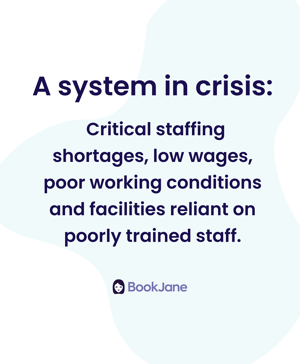Yet staffing shortages and poor training in Ontario’s 626 public and private long-term care facilities have had a negative impact on care, with unsafe medication dispensation, missed baths, lack of access to bathroom facilities and levels of depression, infections, anxiety and conflict on the rise for residents.

In response to a public hearing into the security and safety of long-term care residents, in February 2020 the Ontario Ministry of Long-Term Care launched a study examining the province’s long-term care home system.
Overseen by a ten-person expert panel and led by Arthur Sweetman, an economics professor at McMaster University who holds the Ontario Research Chair in Health Human Resources, the Long-Term Care Staffing Study was drafted as part of Ontario’s plan to modernize the long-term care sector. To complete the study, the authors engaged with a variety of long-term care sector partners, including facility operators, unions, family advocates, academics, healthcare associations and other industry thought leaders, to better understand the range of perspectives on staffing issues facing the sector.
Released to the public in July 2020, the study was published with the aim of offering Ontario’s Ministry of Long-Term Care potential models to support resident safety, quality of care, and long-term care workforce recruitment and retention.
A System in Crisis
The study describes a system in crisis, with critical staffing shortages, low wages, poor working conditions and facilities reliant on poorly trained staff.
To address these challenges and improve staffing across the long-term care facility sector, the study offers recommendations within five priority areas, including potential improvements around staff training, human resource management, funding changes within the system, and overall changes to culture:
1. The number of staff working in long-term care needs to increase and more funding will be required to achieve that goal.
The report recommends a staffing investment with a minimum daily average of four hours of direct care per resident. The report does not outline the amount of funding needed however advocates have estimated the cost of increased staffing to be in the billions.
The report also suggests guidelines for improving staffing ratios and skill mix for PSW’s, nursing staff, and allied health professionals, with variance to address specific circumstances: “Increasing the proportion of full-time, permanent positions would improve working conditions for staff and reduce the likelihood of spreading viruses, such as COVID-19, between homes.”
2. The culture of long-term care needs to change – at both the system and individual home level.
Suggesting that the system undergo a regulatory modernization process, the report outlines the need for improvement in the quality of overall sector oversight, renewed performance measurements, the development of a strong and coherent philosophy of care for facilities, recognition of the critical role of PSW’s and a cultural shift toward a more respectful team environment.
3. Workload and working conditions must get better, to retain staff and improve the conditions for care.
To retain staff the report recommends increased compensation, the option of full-time or part-time employment, a system to protect employees from physical, mental and emotional risk, increased levels of charting and documentation, and more effective medication management.
4. Excellence in long-term care requires effective leadership and access to specialized expertise.
The report calls out the needed to clarify the role and accountability of the Medical Director, expanding the use of Nurse Practitioners, ensuring access to strong Infection Prevention and Control (IPAC) expertise and increased access to specialists.
5. Attract and prepare the right people for employment in long-term care and provide opportunities for learning and growth.
The report suggests attracting people with the right attributes through improved public perception, building stronger relationships with secondary schools, offering enhanced supports for new graduates, and expanding the labour pool. The report also suggests aligning the number of graduates with needs across the health care sector and addressing educational requirements for the long-term care sector by increasing onsite experiences for students, promoting preceptorships, and supporting staff to stay current, gain new skills and develop specialized expertise, including continuing education, micro-credentialing and job laddering.
Long-term care currently employs 100,000 people across the province, in a mix of non-profit, for-profit and municipal homes. The largest proportion of employees in long-term care are personal support workers, registered nursing staff, including registered practical nurses, registered nurses and nurse practitioners, and allied health professionals such as dieticians, activity assistants, occupational and physical therapists and social workers.
Since the study’s release, the government of Ontario has announced:
-
A $10 million annual training fund to help frontline care staff acquire new skills, including “the flexibility and resiliency needed to adapt to changing practices.” This investment follows $243 million in emergency funding already allocated for staffing and supplies, as well as additional funding of $78.2 million to preserve front-line staff and maintain current levels of service for resident care.
-
A three-year, $1.8 million partnership with the Institute for Safe Medication Practices Canada.
-
The promise to launch a Medication Safety Technology program to help homes adopt new technologies to strengthen medication dispensing safety.
Despite the new investment, some critics say that the government needs to invest more – and quickly, before the next, expected wave of COVID-19 hits in the fall.





